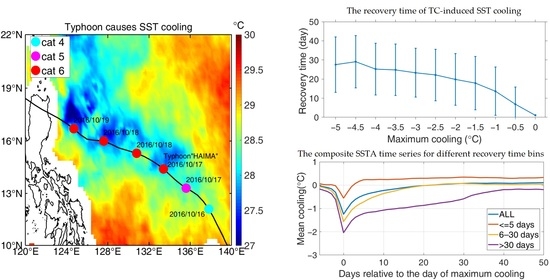Recovery of Tropical Cyclone Induced SST Cooling Observed by Satellite in the Northwestern Pacific Ocean
Abstract
:1. Introduction
2. Data and Method
2.1. Data
2.2. Method
3. Results
3.1. Characteristics of SST Response to TC Passage
3.2. Impacts of the Ocean MLD and UTTG
4. Conclusions
5. Discussion
Author Contributions
Funding
Institutional Review Board Statement
Informed Consent Statement
Data Availability Statement
Conflicts of Interest
References
- Chang, S.W.; Madala, R.V. Numerical Simulation of the Influence of Sea Surface Temperature on Translating Tropical Cyclones. J. Atmos. Sci. 1980, 37, 2617–2630. [Google Scholar] [CrossRef] [Green Version]
- Black, P.G.; Holland, G.J. The Boundary Layer of Tropical Cyclone Kerry (1979). Mon. Weather Rev. 2003, 123, 2007. [Google Scholar] [CrossRef] [Green Version]
- Monaldo, F.M.; Sikora, T.D.; Babin, S.M.; Sterner, R.E. Satellite Imagery of Sea Surface Temperature Cooling in the Wake of Hurricane Edouard (1996). Mon. Weather Rev. 1997, 125, 2716–2721. [Google Scholar] [CrossRef]
- Schade, L.R.; Emanuel, K.A. The Ocean’s Effect on the Intensity of Tropical Cyclones: Results from a Simple Coupled Atmosphere–Ocean Model. J. Atmos. Sci. 1999, 56, 642–651. [Google Scholar] [CrossRef] [Green Version]
- Emanuel, K.; Desautels, C.; Holloway, C.; Korty, R. Environmental Control of Tropical Cyclone Intensity. J. Atmos. Sci. 2004, 61, 843–858. [Google Scholar] [CrossRef]
- Hart, R.E.; Maue, R.N.; Watson, M.C. Estimating Local Memory of Tropical Cyclones through MPI Anomaly Evolution. Mon. Weather Rev. 2007, 135, 3990–4005. [Google Scholar] [CrossRef]
- Huang, P.; Lin, I.I.; Chou, C.; Huang, R.H. Change in ocean subsurface environment to suppress tropical cyclone intensification under global warming. Nat. Commun. 2015, 6, 7188. [Google Scholar] [CrossRef] [PubMed] [Green Version]
- Emanuel, K. Contribution of tropical cyclones to meridional heat transport by the oceans. J. Geophys. Res. 2001, 106, 14771–14781. [Google Scholar] [CrossRef]
- Sriver, R.L.; Huber, M. Observational evidence for an ocean heat pump induced by tropical cyclones. Nature 2007, 447, 577–580. [Google Scholar] [CrossRef]
- Jansen, M.F.; Ferrari, R.; Mooring, T.A. Seasonal versus permanent thermocline warming by tropical cyclones. Geophys. Res. Lett. 2010, 37, 202–217. [Google Scholar] [CrossRef]
- Fisher, E.L. Hurricanes and the Sea-Surface Temperature Field. J. Atmos. Sci. 1958, 15, 328–333. [Google Scholar] [CrossRef]
- Leipper, D.F. Observed Ocean Conditions and Hurricane Hilda, 1964. J. Atmos. Sci. 1967, 24, 182–186. [Google Scholar] [CrossRef] [Green Version]
- Fedorov, K.; Varfolomeev, A.; Ginzburg, A.; Zatsepin, A.; Krasnopevtsev, A.Y.; Ostrovsky, A.; Skylarov, V. Thermal reaction of the ocean on the passage of the hurricane “Ella”. Oceanology 1979, 19, 992–1001. [Google Scholar]
- Price, J.F. Upper Ocean Response to a Hurricane. J. Phys. Oceanogr. 1981, 11, 153–175. [Google Scholar] [CrossRef] [Green Version]
- Shay, L.K.; Black, P.G.; Mariano, A.J.; Hawkins, J.D.; Elsberry, R.L. Upper ocean response to Hurricane Gilbert. J. Geophys. Res. 1992, 97, 20227–20248. [Google Scholar] [CrossRef] [Green Version]
- Price, J.F.; Morzel, J.; Niiler, P.P. Warming of SST in the cool wake of a moving hurricane. J. Geophys. Res. 2008, 113, C07010. [Google Scholar] [CrossRef] [Green Version]
- Hart, R.E. An inverse relationship between aggregate northern hemisphere tropical cyclone activity and subsequent winter climate. Geophys. Res. Lett. 2011, 38, 302–312. [Google Scholar] [CrossRef]
- Osuri, K.K.; Nadimpalli, R.; Mohanty, U.C.; Niyogi, D. Prediction of rapid intensification of tropical cyclone Phailin over the Bay of Bengal using the HWRF modelling system. Q. J. R. Meteorol. Soc. 2017, 143, 678–690. [Google Scholar] [CrossRef]
- Pei, Y.; Zhang, R.H.; Chen, D. Roles of different physical processes in upper ocean responses to Typhoon Rammasun (2008)—induced wind forcing. Sci. China Earth Sci. 2019, 062, 684–692. [Google Scholar] [CrossRef]
- Pudov, V.D.; Varfolomeyev, A.A.; Fedorov, K.N. Vertical structure of the wake of a typhoon in the upper ocean. Oceanol. Acad. Sci. USSR 1978, 18, 142–146. [Google Scholar]
- Chu, P.C.; Veneziano, J.M.; Fan, C.; Carron, M.J.; Liu, W.T. Response of the South China Sea to Tropical Cyclone Ernie 1996. J. Geophys. Res. 2000, 105, 13991–14009. [Google Scholar] [CrossRef] [Green Version]
- Davis, C.; Wang, W.; Chen, S.S.; Chen, Y.; Corbosiero, K.; DeMaria, M.; Dudhia, J.; Holland, G.; Klemp, J.; Michalakes, J.; et al. Prediction of Landfalling Hurricanes with the Advanced Hurricane WRF Model. Mon. Weather Rev. 2008, 136, 1990–2005. [Google Scholar] [CrossRef] [Green Version]
- Mahapatra, D.K.; Rao, A.D.; Babu, S.V.; Srinivas, C. Influence of coast line on upper ocean’s response to the tropical cyclone. Geophys. Res. Lett. 2007, 34, L17603. [Google Scholar] [CrossRef] [Green Version]
- Mandal, S.; Sil, S.; Shee, A.; Venkatesan, R. Upper Ocean and Subsurface Variability in the Bay of Bengal During Cyclone ROANU: A Synergistic View Using In Situ and Satellite Observations. Pure Appl. Geophys. 2018, 175, 4605–4624. [Google Scholar] [CrossRef]
- Prasad, T.G.; Hogan, P.J. Upper-ocean response to Hurricane Ivan in a 1/25 nested Gulf of Mexico HYCOM. J. Geophys. Res. 2007, 112, C04013. [Google Scholar] [CrossRef] [Green Version]
- Taira, K.; Kitagawa, S.; Otobe, H.; Asai, T. Observation of temperature and velocity from a surface buoy moored in the Shikoku Basin (OMLET-88)—An oceanic response to a Typhoon. J. Oceanogr. 1993, 49, 397–406. [Google Scholar] [CrossRef] [Green Version]
- Cione, J.J.; Uhlhorn, E.W. Sea Surface Temperature Variability in Hurricanes: Implications with Respect to Intensity Change. Mon. Weather Rev. 2003, 128, 1783–1796. [Google Scholar] [CrossRef] [Green Version]
- Lin, I.I.; Liu, W.T.; Wu, C.C.; Chiang, J.; Sui, C.H. Satellite observations of modulation of surface winds by typhoon-induced upper ocean cooling. Geophys. Res. Lett. 2003, 30, 1131. [Google Scholar] [CrossRef]
- Chiang, T.L.; Wu, C.R.; Oey, L.Y. Typhoon Kai-Tak: An Ocean’s Perfect Storm. J. Phys. Oceanogr. 2011, 41, 221–233. [Google Scholar] [CrossRef]
- Dare, R.A.; McBride, J.L. Sea Surface Temperature Response to Tropical Cyclones. Mon. Weather Rev. 2011, 139, 3798–3808. [Google Scholar] [CrossRef]
- Hazelworth, J.B. Water temperature variations resulting from hurricanes. J. Geophys. Res. 1968, 73, 5105–5123. [Google Scholar] [CrossRef]
- Nelson, N.B. Cover The wake of Hurricane Felix. Int. J. Remote Sens. 1996, 17, 2893–2895. [Google Scholar] [CrossRef]
- Lin, I.I.; Wu, C.; Pun, I.; Ko, D. Upper-Ocean Thermal Structure and the Western North Pacific Category 5 Typhoons. Part I: Ocean Features and the Category 5 Typhoons’ Intensification. Mon. Weather Rev. 2008, 136, 3288–3306. [Google Scholar] [CrossRef] [Green Version]
- Lin, I.I.; Pun, I.F.; Wu, C.C. Upper-Ocean Thermal Structure and the Western North Pacific Category 5 Typhoons. Part II: Dependence on Translation Speed. Mon. Weather Rev. 2009, 137, 3744–3757. [Google Scholar] [CrossRef]
- Jacob, S.D.; Shay, L.K.; Mariano, A.J.; Black, P.G. The 3D oceanic mixed layer response to Hurricane Gilbert. J. Phys. Oceanogr. 2000, 30, 1407–1429. [Google Scholar] [CrossRef]
- Pothapakula, P.K.; Osuri, K.K.; Pattanayak, S.; Mohanty, U.C.; Sil, S.; Nadimpalli, R. Observational perspective of SST changes during life cycle of tropical cyclones over Bay of Bengal. Nat. Hazards 2017, 88, 1769–1787. [Google Scholar] [CrossRef]
- Lin, I.-I.; Black, P.; Price, J.F.; Yang, C.-Y.; Chen, S.S.; Lien, C.-C.; Harr, P.; Chi, N.-H.; Wu, C.-C.; D’Asaro, E.A. An ocean coupling potential intensity index for tropical cyclones. Geophys. Res. Lett. 2013, 40, 1878–1882. [Google Scholar] [CrossRef]
- Yesubabu, V.; Kattamanchi, V.K.; Vissa, N.K.; Dasari, H.P.; Sarangam, V.B.R. Impact of ocean mixed-layer depth initialization on the simulation of tropical cyclones over the Bay of Bengal using the WRF-ARW model. Meteorol. Appl. 2020, 27, e1862. [Google Scholar] [CrossRef]
- Fu, H.; Wang, X.; Chu, P.C.; Zhang, X.; Han, G.; Li, W. Tropical cyclone footprint in the ocean mixed layer observed by Argo in the Northwest Pacific. J. Geophys. Res. Oceans 2014, 119, 8078–8092. [Google Scholar] [CrossRef] [Green Version]
- Park, J.J.; Kwon, Y.-O.; Price, J.F. Argo array observation of ocean heat content changes induced by tropical cyclones in the north Pacific. J. Geophys. Res. Oceans 2011, 116, C12025. [Google Scholar] [CrossRef]
- Knapp, K.R.; Kruk, M.C.; Levinson, D.H.; Diamond, H.J.; Neumann, C.J. The International Best Track Archive for Climate Stewardship (IBTrACS). Bull. Am. Meteorol. Soc. 2010, 91, 363–376. [Google Scholar] [CrossRef]
- Liang, J.; Ren, F.-M.; Yang, X.-Q. Study on the differences between CMA and JTWC tropical cyclone datasets for northwest Pacific. Acta Oceanol. Sinica. Chin. Ed./Haiyang Xuebao 2010, 32, 10–22. [Google Scholar]
- Ren, F.; Liang, J.; Wu, G.; Dong, W.; Yang, X. Reliability Analysis of Climate Change of Tropical Cyclone Activity over the Western North Pacific. J. Clim. 2011, 24, 5887–5898. [Google Scholar] [CrossRef]
- Ruirui, Z. New Level Standard of Tropical Cyclone and Relevant Terminology. China Terminol. 2007, 9, 56. [Google Scholar] [CrossRef]
- Cheng, L.; Trenberth, K.E.; Fasullo, J.; Boyer, T.; Abraham, J.; Zhu, J. Improved estimates of ocean heat content from 1960 to 2015. Sci. Adv. 2017, 3, e1601545. [Google Scholar] [CrossRef] [PubMed] [Green Version]
- De Boyer Montégut, C.; Madec, G.; Fischer, A.S.; Lazar, A.; Iudicone, D. Mixed layer depth over the global ocean: An examination of profile data and a profile-based climatology. J. Geophys. Res. 2004, 109, C12003. [Google Scholar] [CrossRef]
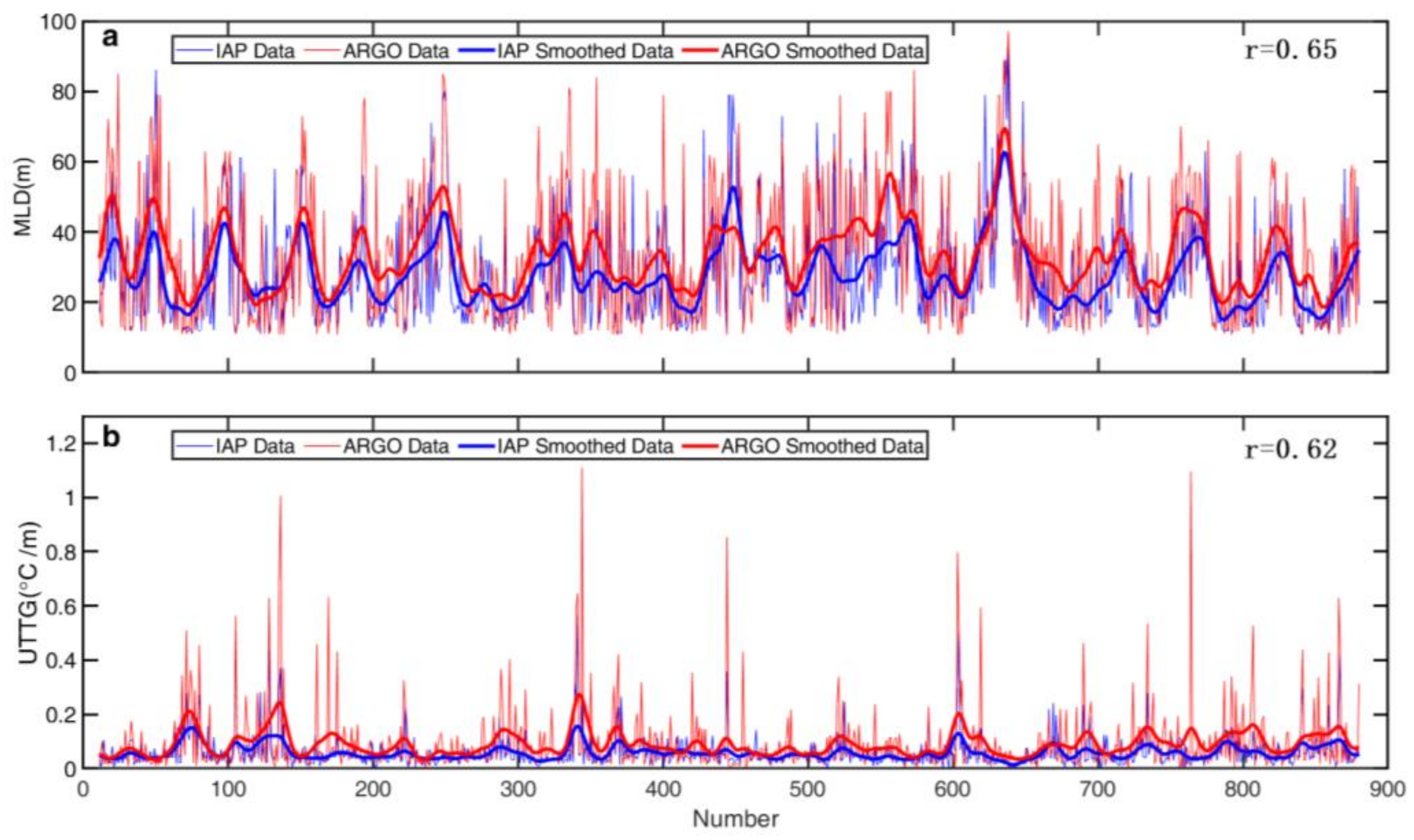
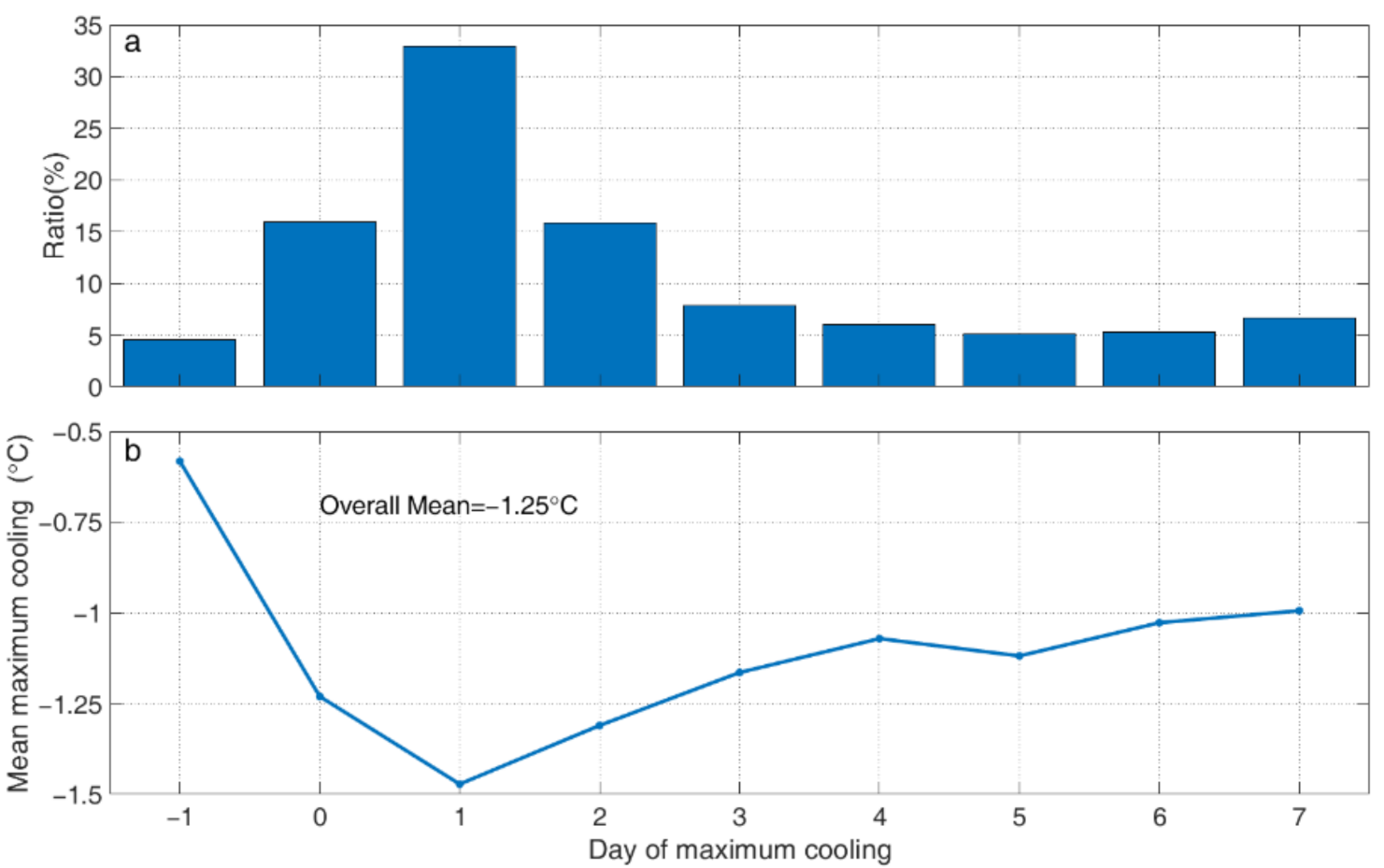
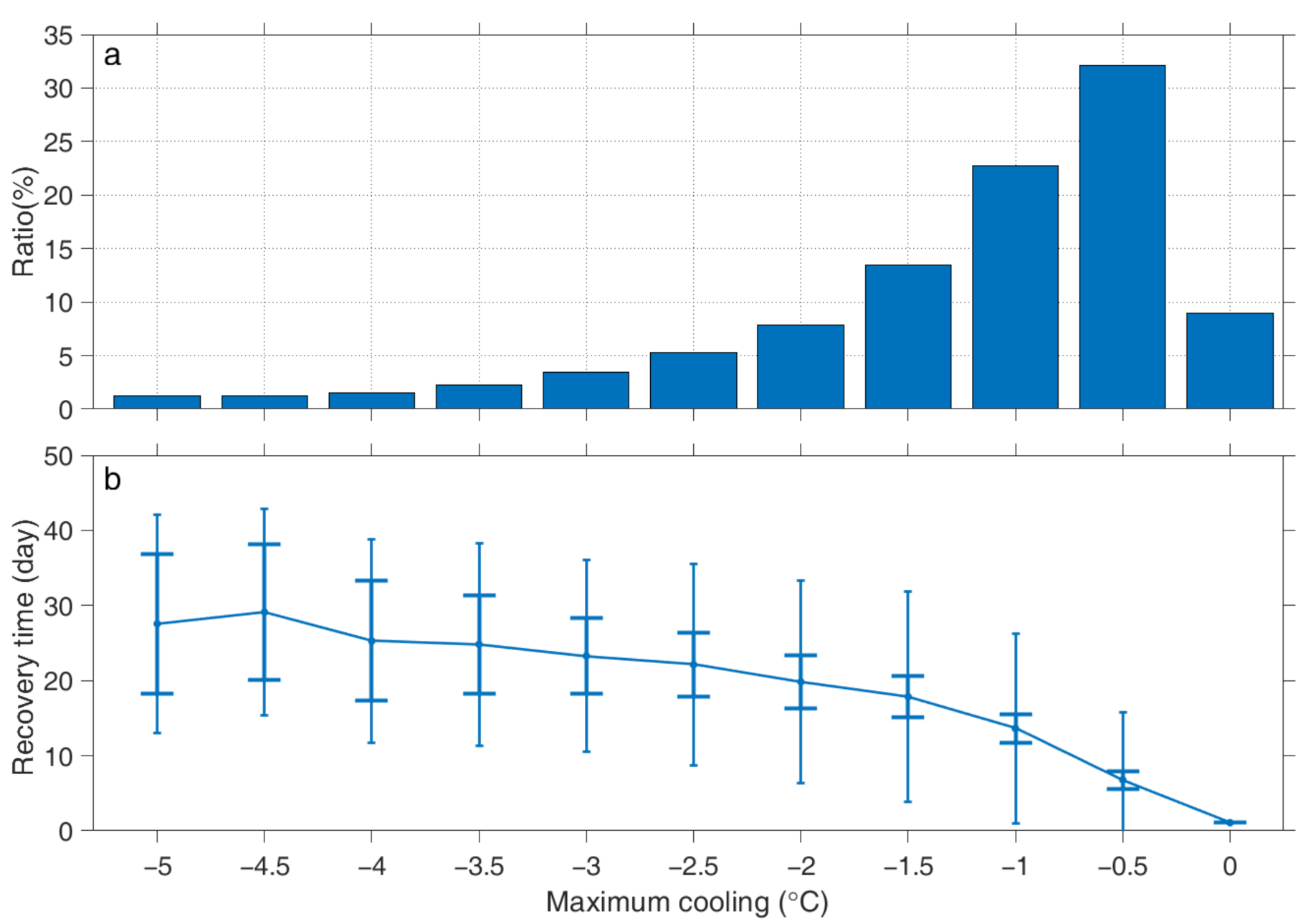
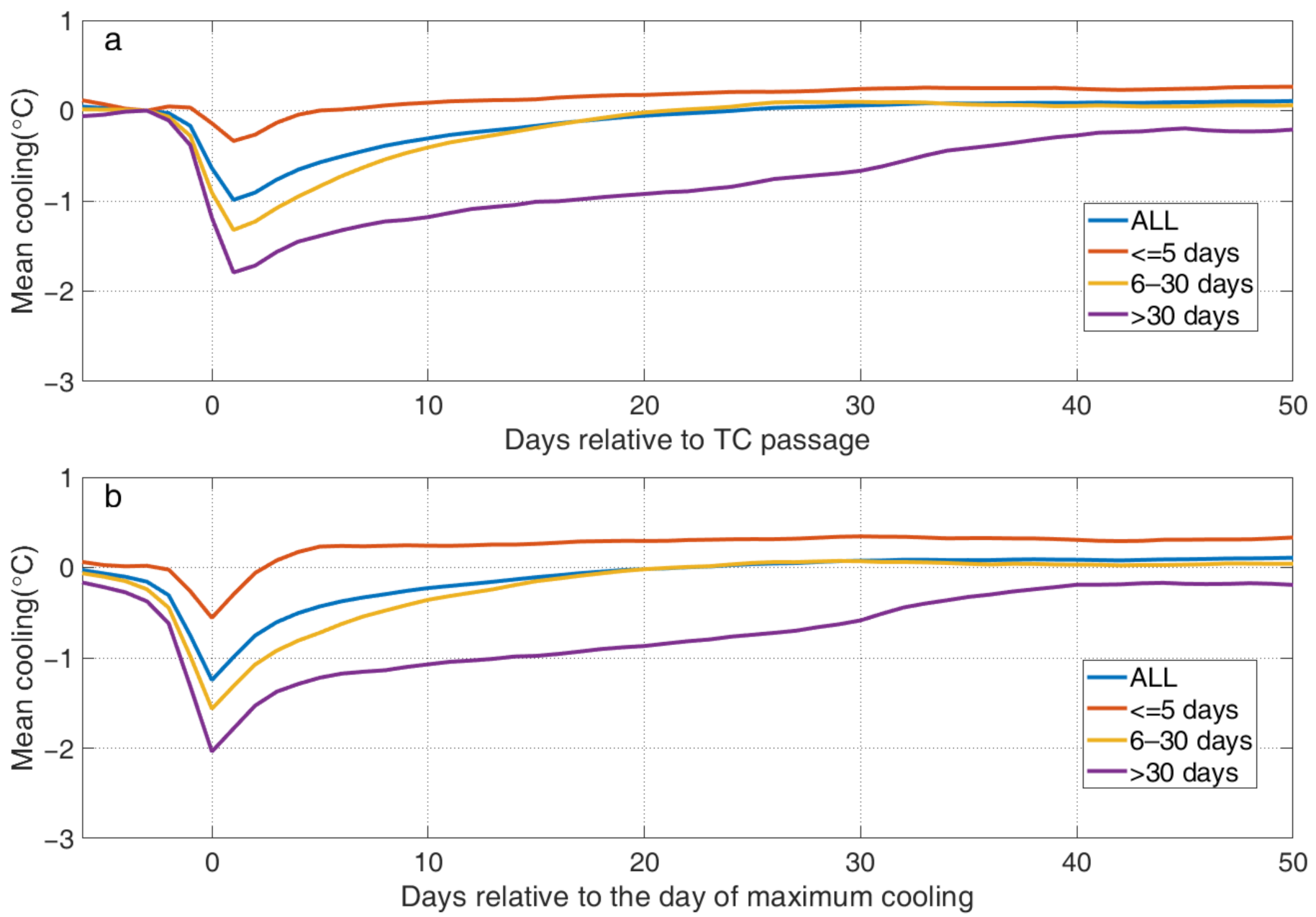
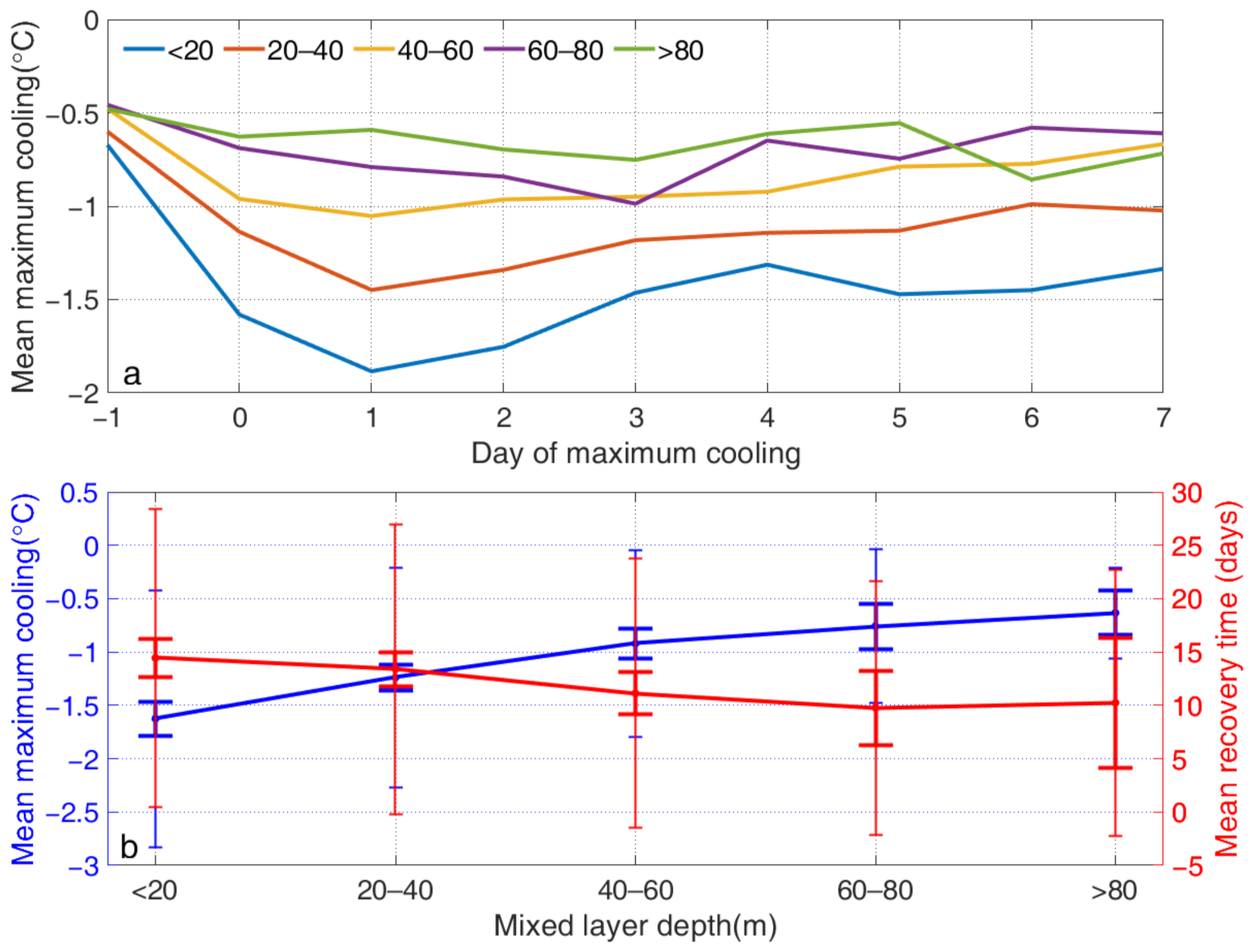
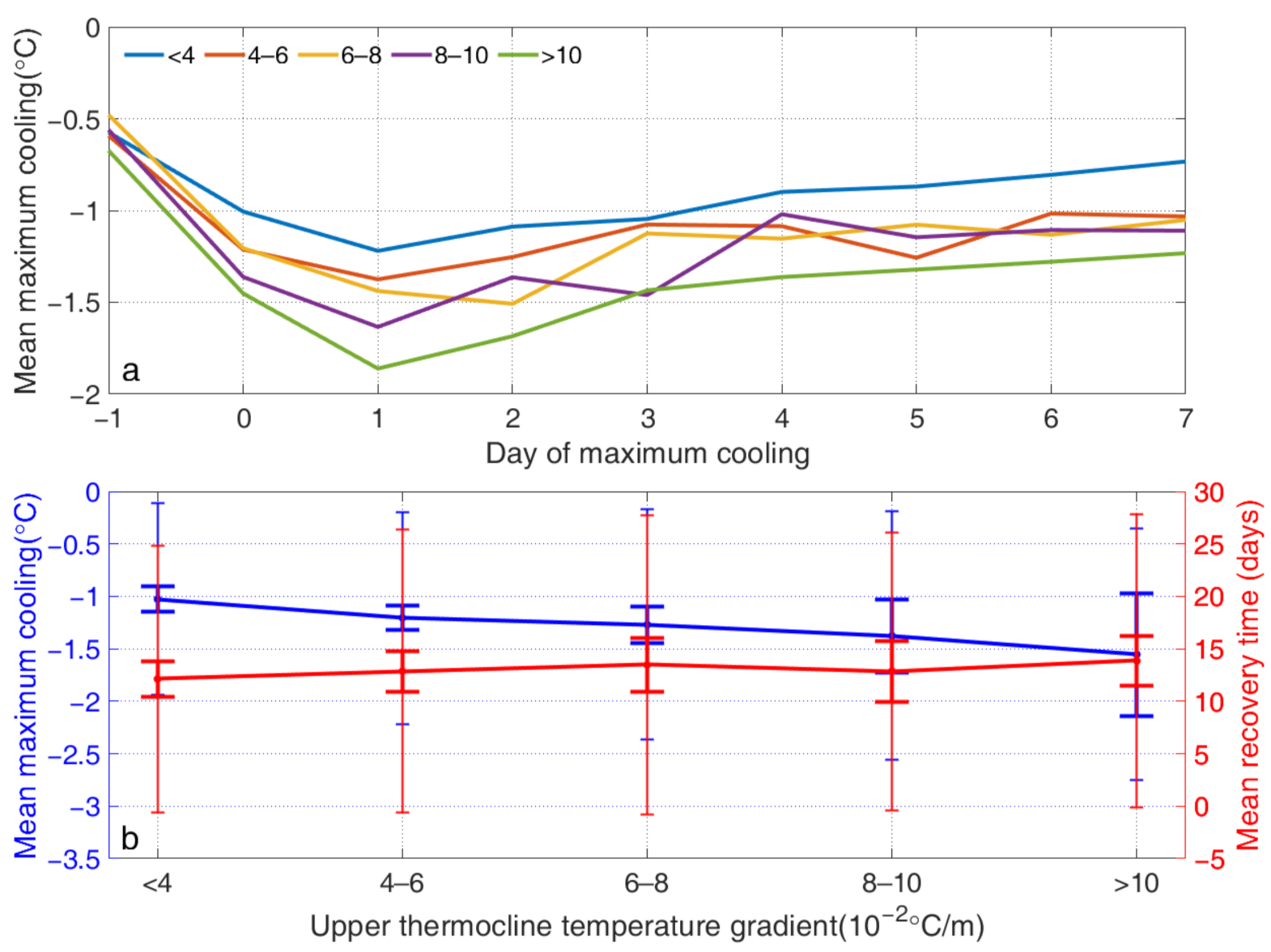
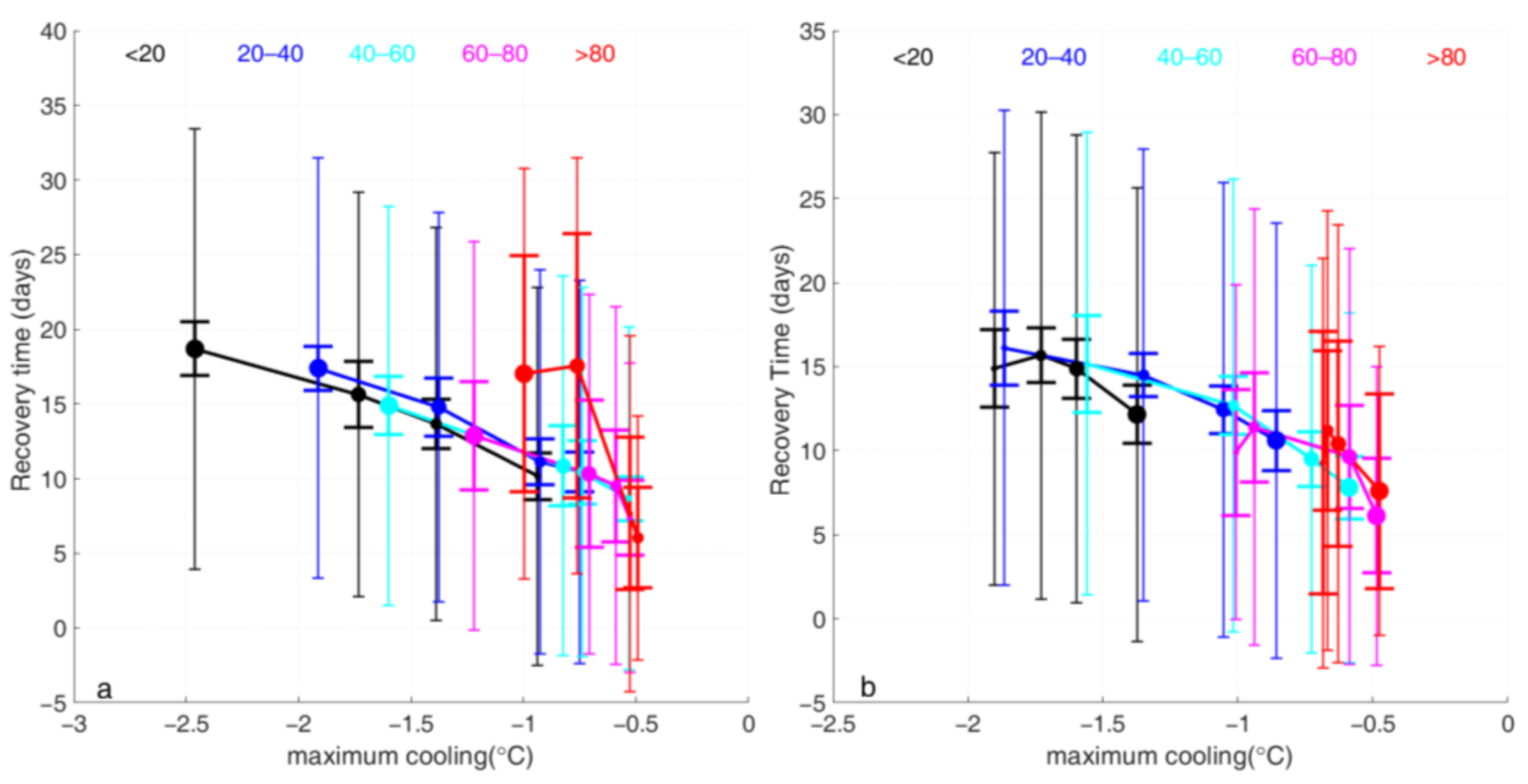

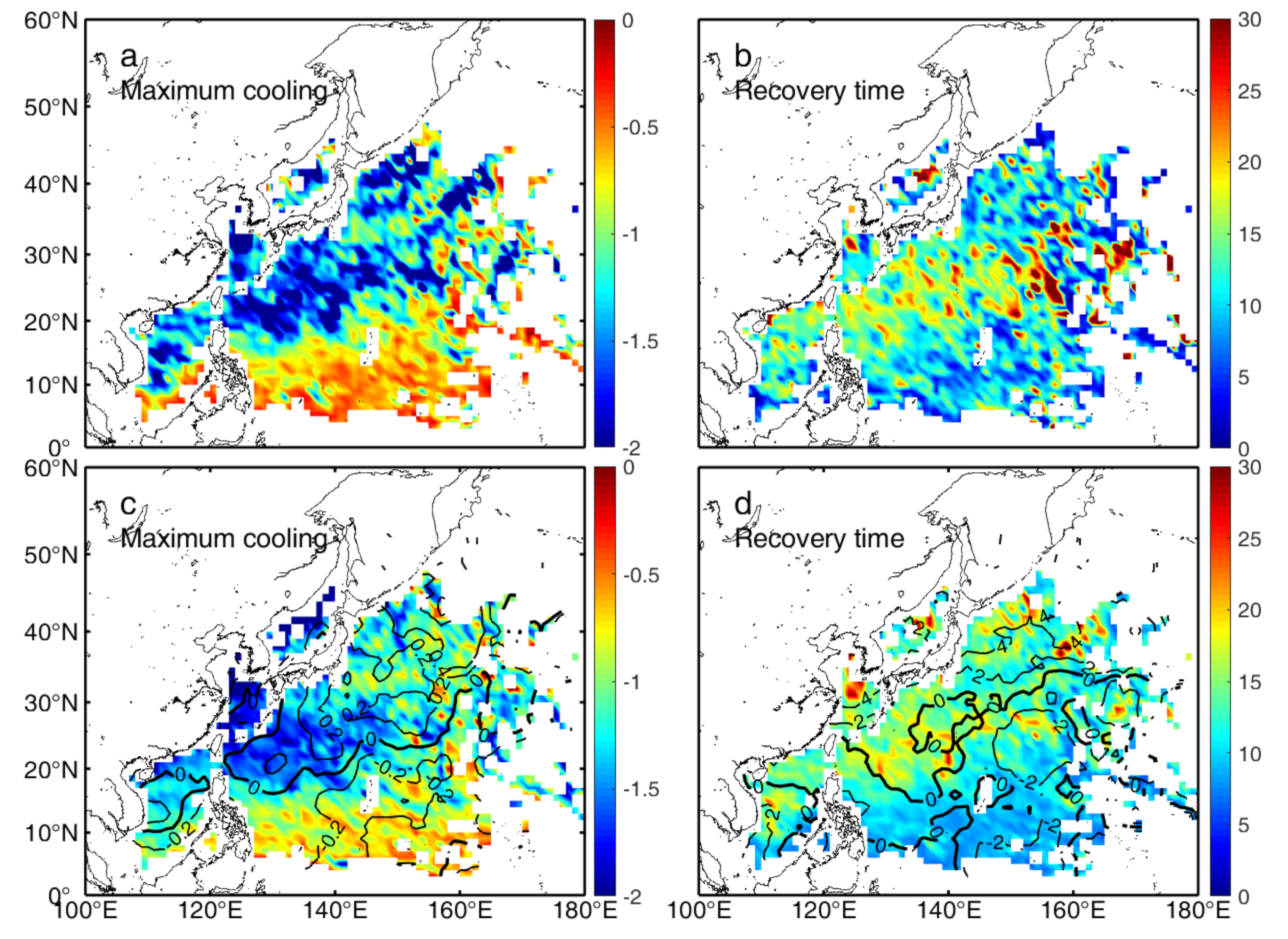
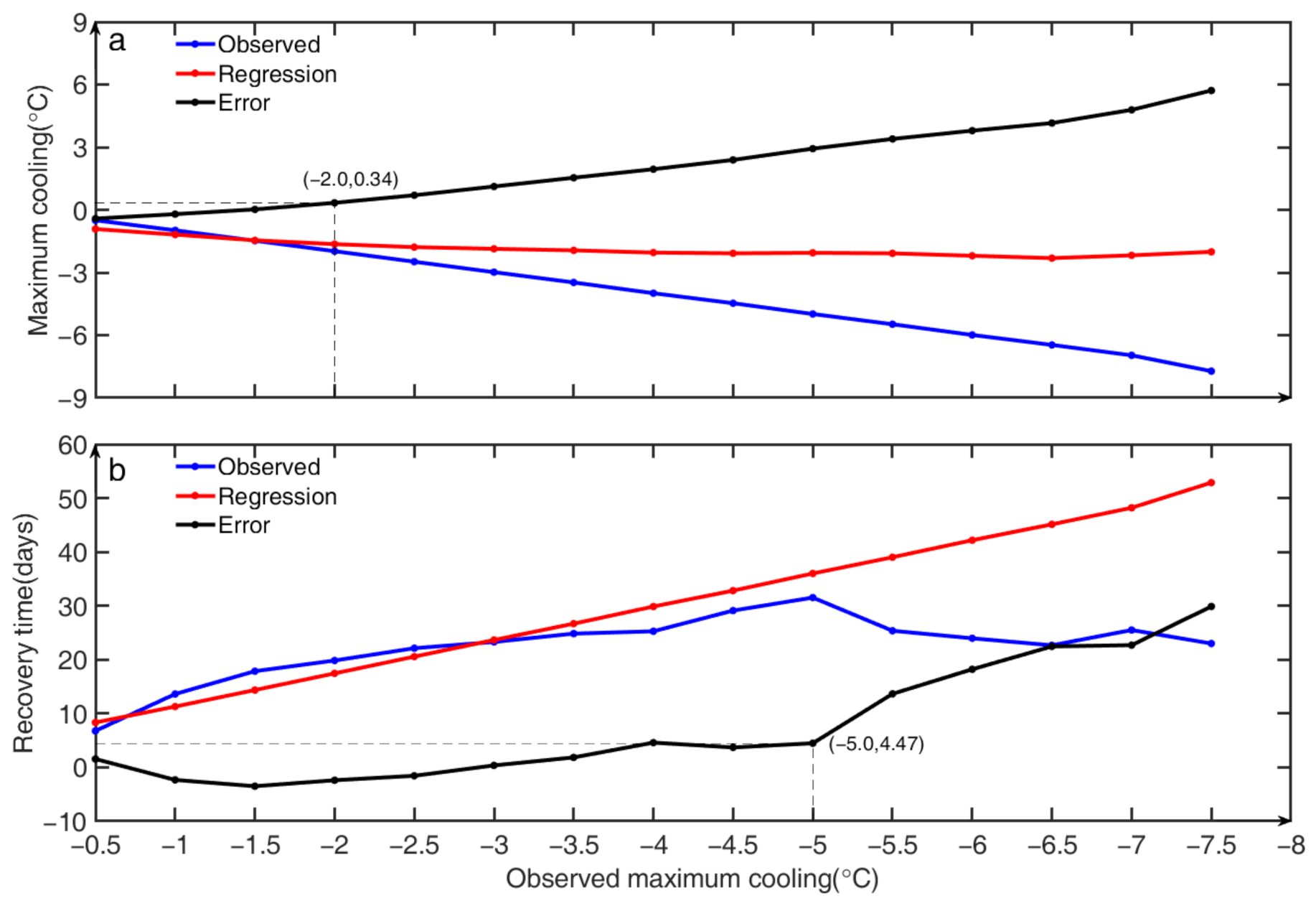
| Bin | MLD (m) | Mean Maximum Cooling (°C) | Mean Recovery Time (Days) | Observations (%) |
|---|---|---|---|---|
| 1 | 0–20 | −1.62 ± 1.20 | 14.4 ± 13.9 | 30.8 |
| 2 | 20–40 | −1.24 ± 1.03 | 13.4 ± 13.6 | 39.1 |
| 3 | 40–60 | −0.92 ± 0.87 | 11.1 ± 12.6 | 21.8 |
| 4 | 60–80 | −0.76 ± 0.72 | 9.8 ± 11.9 | 6.1 |
| 5 | >80 | −0.63 ± 0.43 | 10.2 ± 12.5 | 2.2 |
| Bin | UTTG (10−2 °C/m) | Mean Maximum Cooling (°C) | Mean Recovery Time (Day) | Observations (%) |
|---|---|---|---|---|
| 1 | 0–4 | −1.03 ± 0.91 | 12.1 ± 12.7 | 29.0 |
| 2 | 4–6 | −1.20 ± 1.01 | 12.9 ± 13.5 | 25.4 |
| 3 | 6–8 | −1.27 ± 1.10 | 13.5 ± 14.2 | 16.3 |
| 4 | 8–10 | −1.38 ± 1.18 | 12.9 ± 13.2 | 11.0 |
| 5 | >10 | −1.55 ± 1.20 | 13.9 ± 13.9 | 18.4 |
| MLD Bin | TD | TS | STS | TY |
|---|---|---|---|---|
| 1 0–20 m | −0.94 ± 0.67 (10.2 ± 12.7) | −1.39 ± 0.88 (13.7 ± 13.2) | −1.73 ± 1.18 (15.6 ± 13.5) | −2.46 ± 1.37 (18.7 ± 14.7) |
| 2 20–40 m | −0.75 ± 0.61 (10.5 ± 12.8) | −0.93 ± 0.70 (11.1 ± 12.8) | −1.38 ± 0.90 (14.8 ± 13.0) | −1.91 ± 1.23 (17.4 ± 14.1) |
| 3 40–60 m | −0.53 ± 0.34 (8.7 ± 11.5) | −0.74 ± 0.52 (10.4 ± 12.4) | −0.82 ± 0.57 (10.8 ± 12.7) | −1.60 ± 1.21 (14.9 ± 13.4) |
| 4 60–80 m | −0.53 ± 0.40 (7.4 ± 10.4) | −0.59 ± 0.34 (9.5 ± 12.0) | −0.71 ± 0.50 (10.3 ± 12.0) | −1.22 ± 1.07 (12.9 ± 13.0) |
| 5 >80 m | −0.53 ± 0.32 (7.7 ± 11.9) | −0.49 ± 0.29 (6.0 ± 8.2) | −0.76 ± 0.34 (17.5 ± 13.9) | −1.00 ± 0.61 (17.0 ± 13.7) |
| MLD Bin | 0–2.5 m/s | 2.5–5 m/s | 5–7.5 m/s | >7.5 m/s |
|---|---|---|---|---|
| 1 0–20 m | −1.90 ± 1.35 (14.9 ± 12.9) | −1.73 ± 1.25 (15.7 ± 14.5) | −1.60 ± 1.15 (14.9 ± 13.9) | −1.37 ± 1.05 (12.2 ± 13.5) |
| 2 20–40 m | −1.86 ± 1.40 (16.1 ± 14.1) | −1.35 ± 1.03 (14.5 ± 13.4) | −1.05 ± 0.83 (12.4 ± 13.5) | −0.86 ± 0.65 (10.6 ± 12.9) |
| 3 40–60 m | −1.56 ± 1.39 (15.2 ± 13.8) | −1.02 ± 0.86 (12.7 ± 13.5) | −0.73 ± 0.58 (9.5 ± 11.5) | −0.59 ± 0.39 (7.8 ± 10.4) |
| 4 60–80 m | −1.01 ± 1.09 (9.9 ± 10.0) | −0.94 ± 0.80 (11.4 ± 13.0) | −0.59 ± 0.41 (9.6 ± 12.4) | −0.49 ± 0.35 (6.1 ± 8.9) |
| 5 >80 m | −0.69 ± 0.38 (9.3 ± 12.2) | −0.67 ± 0.46 (11.2 ± 13.1) | −0.63 ± 0.45 (10.4 ± 13.0) | −0.48 ± 0.26 (7.6 ± 8.6) |
Publisher’s Note: MDPI stays neutral with regard to jurisdictional claims in published maps and institutional affiliations. |
© 2021 by the authors. Licensee MDPI, Basel, Switzerland. This article is an open access article distributed under the terms and conditions of the Creative Commons Attribution (CC BY) license (https://creativecommons.org/licenses/by/4.0/).
Share and Cite
Ling, Z.; Chen, Z.; Wang, G.; He, H.; Chen, C. Recovery of Tropical Cyclone Induced SST Cooling Observed by Satellite in the Northwestern Pacific Ocean. Remote Sens. 2021, 13, 3781. https://doi.org/10.3390/rs13183781
Ling Z, Chen Z, Wang G, He H, Chen C. Recovery of Tropical Cyclone Induced SST Cooling Observed by Satellite in the Northwestern Pacific Ocean. Remote Sensing. 2021; 13(18):3781. https://doi.org/10.3390/rs13183781
Chicago/Turabian StyleLing, Zheng, Zhifeng Chen, Guihua Wang, Hailun He, and Changlin Chen. 2021. "Recovery of Tropical Cyclone Induced SST Cooling Observed by Satellite in the Northwestern Pacific Ocean" Remote Sensing 13, no. 18: 3781. https://doi.org/10.3390/rs13183781
APA StyleLing, Z., Chen, Z., Wang, G., He, H., & Chen, C. (2021). Recovery of Tropical Cyclone Induced SST Cooling Observed by Satellite in the Northwestern Pacific Ocean. Remote Sensing, 13(18), 3781. https://doi.org/10.3390/rs13183781






